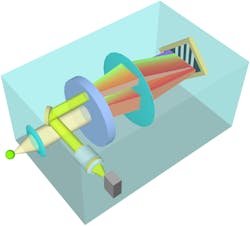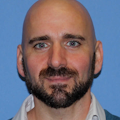Are discrete-wavelength QCL arrays the future of mid-IR spectroscopy?
The December 2021 issue of Laser Focus World featured an exciting new method of sub-diffraction-limited infrared (IR) imaging, known as fluorescence-detected photothermal infrared (F-PTIR) microscopy.1 In addition to the technical novelty of F-PTIR, there was also a fascinating human aspect presented in that article. Two research teams at Purdue University (West Lafayette, IN) and Boston University (Boston, MA) had both independently developed F-PTIR at the exact same time—even going so far as to publish their manuscripts in the same issue of the Journal of the American Chemical Society (JACS).2,3
While virtually identical, there was one significant difference between the experimental approaches of the two teams. Ji-Xin Cheng’s group in Boston used the MIRcat-2400, a continuously tunable quantum-cascade laser (QCL) from DRS Daylight Solutions (San Diego, CA), whereas Garth Simpson’s team at Purdue chose to use a monolithic array of 32 fixed wavelength QCLs (see Fig. 1) from Pendar Technologies (Cambridge, MA). From the perspective of F-PTIR microscopy, the difference in laser source has little to no impact. But, from the perspective of IR spectroscopy in general, Simpson’s approach has the potential to be quite revolutionary.
The use of monolithic QCL arrays for IR spectroscopy is not a novel idea.4,5 However, Simpson’s use of binary-matrix signal processing in conjunction with a QCL array is genuinely novel, with advantages in both signal-to-noise ratio (SNR) and acquisition speed. That being said, the only way to fully understand these benefits is by looking at the underlying signal processing algorithm, not just the laser platform. Therefore, we decided it would be best to revisit this aspect of the story in a follow-up feature where we could take the time to explore the topic properly.
What is a Hadamard transform?
Most people in the optics community are familiar with Fourier transform theory, allowing any function to be represented as a summation of sines and cosines. This concept is straightforward for laser engineers to visualize when converting between a laser pulse’s temporal and frequency characteristics or modeling far-field diffraction as the Fourier transform of an aperture. In image processing, two-dimensional Fourier transforms are used to decompose an image into a collection of spatial frequencies, corresponding to the image’s slowly and rapidly varying features. Since the slowly varying features tend to be more visually discernible than rapidly varying ones, you can often eliminate the higher-frequency components of the Fourier transformed image without any noticeable impact.
This is the fundamental principle behind image compression because it allows for the selective removal of data without a perceivable degradation in quality. In practice, though, doing Fourier transforms on images is still too data-intensive for high-speed image transmission, such as streaming video, because of the Fourier transform’s complex nature (phase and amplitude). One common way of simplifying image processing is to utilize a cosine transformation, eliminating the need for complex numbers. The Hadamard transform takes this simplification one step further by replacing the cosine functions, which continuously vary from +1 to -1, with a binarized matrix.
Therefore, the Hadamard transform allows for the decomposition of any image into a series of discrete matrices having the same grouping properties as the frequency components in a Fourier transform. The most common application of Hadamard transformation-based compression is in high-speed video streaming. For example, the reason why image resolution suddenly decreases or “pixelates” when your internet bandwidth drops is because the higher-frequency portions of the data stream get clipped. In the world of optics, one can replace the negative elements of the Hadamard transform matrix with zeros (off states) to produce a binary mask in the spatial, frequency, or temporal domain.
Hadamard transform spectroscopy
Hadamard transform spectroscopy was proposed by Ibbett, Aspinall, and Grainger6 in 1967 and experimentally verified by Decker and Harwit with a series of experiments published between 1968 and 1971.7-9 But due to a combination of factors, including technological limitations of the time, the technique never reached the mainstream. One quantitative measure of just how little attention Hadamard transform spectroscopy has received is the fact that, according to Google Scholar, Decker and Harwit’s seminal paper “Experimental operation of a Hadamard spectrometer” has only been cited 60 times since its publication in 1969. Luckily, there appears to be a bit of a rediscovery of this technique more than half a century after their initial work.
In 2020, Quan Liu’s group at Nanyang Technological University (Singapore) published an incredibly detailed paper where they presented a microelectromechanical system (MEMS)-based Hadamard transform spectrometer (see Fig. 2).10 The team at Nanyang used a volume phase holographic grating from Wasatch Photonics (Logan, UT) to disperse the spectra of a broadband light source, which was then focused onto a Texas Instruments (Dallas, TX) digital micromirror device (DMD). The DMD was configured so that they could selectively reflect up to 128 binary wavelengths across the spectrum, which are then recombined through the same grating and detected with a Hamamatsu (Shizuoka, Japan) photomultiplier tube (PMT).With this setup, they could program the DMD to scan through each row of the corresponding Hadamard mask. After the system was calibrated, they simply calculated the inverse Hadamard transform of the PMT signal and reconstructed the spectrum. They demonstrated a root-mean-square error (RMSE) of only 3.34% at an 8X compression rate, greatly reducing the spectral acquisition time with minimal spectral degradation. Even at a 16X compression rate, the RMSE only increased to 5.72%.
In addition to the reduction in acquisition time, there is also a significant SNR advantage from the multiplexed nature of Hadamard transform spectroscopy. As Peter Fellgett discovered in the 1940s during his Ph.D. research at the University of Cambridge (Cambridge, UK), the SNR is proportional to the square root of the number of spectral lines incident on the detector. Surprisingly, while the study authors acknowledged this advantage in their impact statement and introduction, they omitted any experimental SNR analysis.
QCL array-based Hadamard spectroscopy
In IR spectroscopy, Fellgett’s advantage is often cited as one of the primary advantages of Fourier transform infrared (FT-IR) spectrometers, since the entire frequency domain is incident on the detector simultaneously. But, as discussed in a previous issue,11 the signal-strength advantage in QCL-based IR microscopy provides orders-of-magnitude faster acquisition rates, thereby effectively rendering the FT-IR Fellgett advantage moot.
By utilizing an individually addressable QCL array for Hadamard transform spectroscopy instead of a binary mask, Simpson’s team at Purdue was effectively taking advantage of the best of both worlds. Through the use of a QCL array, they can maintain high spectral irradiance at the sample while simultaneously achieving Hadamard compression and multiplex SNR improvement.
When asked to comment, Simpson said “a critical aspect for us has been the fast spectral scanning of the QCL array … we can acquire a full 32 channel spectrum in just a few microseconds.” He continued by explaining that “rapid tuning of independently programmable channels allows Hadamard transform spectroscopy, in which patterns consisting of roughly half the channels are activated in rapid succession ... measurements by wavelength tuning one wavelength per frame lack a multiplex advantage and have the potential to introduce 1/f noise in the spectral acquisition.”
Based on their initial publication, one would naturally assume that the limited wavelength range of the array, 1190 to 1330 cm-1 (7.52–8.62 µm), would be problematic, particularly when compared to the tunable QCL used in Boston with a range of 1000 to 1886 cm-1 (5.3–10 µm). But, when Pendar was contacted, they clarified that they are now able to integrate up to four different arrays into a single module. This expands the wavelength range to 935 to 1515 cm-1 (6.6–10.7 µm) and increases the number of potential multiplex channels from 32 to 128 (see Fig. 3).Furthermore, according to Christian Pflügl, senior director at Pendar Technologies and co-author on the Purdue F-PTIR paper, “in comparison to other broadband mid-IR sources such as the external cavity [laser], our QCL array is built on the mature and commercially viable DFB QCL technology … as a monolithically integrated multi-laser source, broadband tuning is enabled simply by activating the DFB QCL of choice.”
While it is still far too early to tell if the approach will take off in the world of IR spectroscopy, the ability to collect a high-quality IR spectrum in a few microseconds is undoubtedly beneficial—particularly for IR microscopy, where a single image can consist of hundreds to thousands of individual spectra, and in portable handheld IR spectrometers where SNR and integration times have historically been a major limitation.
REFERENCES
1. R. V. Chimenti, Laser Focus World, 57, 12, 39−42 (Dec. 2021); see https://bit.ly/3AgqCDJ.
2. M. Li et al., J. Am. Chem. Soc., 143, 10809−10815 (2021).
3. Y. Zhang et al., J. Am. Chem. Soc., 143, 11490−11499 (2021).
4. J. Wallace, Laser Focus World, 49, 3, 24 (Mar. 2013); https://bit.ly/34ZD9Qh.
5. M. Witinski et al., Laser Focus World, 51, 11, 36−39 (Nov. 2015); https://bit.ly/3nCqnNZ.
6. R. N. Ibbett, D. Aspinall, and J. F. Grainger, Appl. Opt., 7, 1089−1093 (1968).
7. J. A. Decker and M. O. Harwit, Appl. Opt., 7, 2205−2209 (1968).
8. J. A. Decker and M. Harwit, Appl. Opt., 8, 2552−2554 (1969).
9. J. A. Decker, Appl. Opt., 10, 510–514 (1971).
10. Y. Zhang, J. Kang, C.-M. Hsieh, and Q. Liu, IEEE Photon. J., 12, 5, 1−8 (Oct. 2020); doi:10.1109/jphot.2020.3026829.
11. R. V. Chimenti, Laser Focus World, 57, 7, 43–46 (Jul. 2021); https://bit.ly/3EXuf2v.
About the Author
Robert V. Chimenti
Director, RVC Photonics LLC
Robert V. Chimenti is the Director of RVC Photonics LLC (Pitman, NJ), as well as a Visiting Assistant Professor in the Department of Physics and Astronomy at Rowan University (Glassboro, NJ). He has earned undergraduate degrees in physics, photonics, and business administration, as well as an M.S. in Electro-Optics from the University of Dayton. Over a nearly 20-year career in optics and photonics, he has primarily focused on the development of new laser and spectroscopy applications, with a heavy emphasis on vibrational spectroscopy. He is also very heavily involved in the Federation of Analytical Chemistry and Spectroscopy Societies (FACSS), where he has served for several years as the Workshops Chair for the annual SciX conference and will be taking over as General Chair for the 2021 SciX conference.



